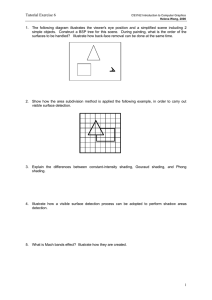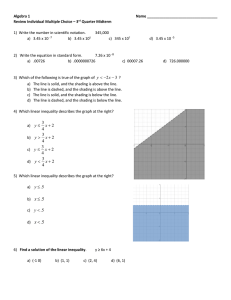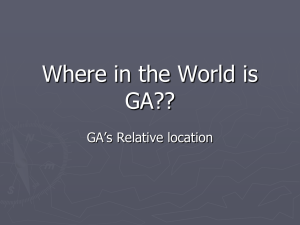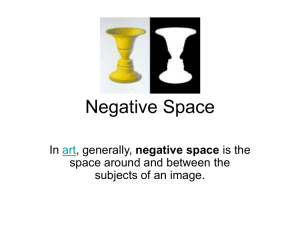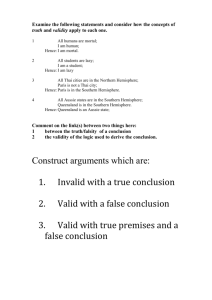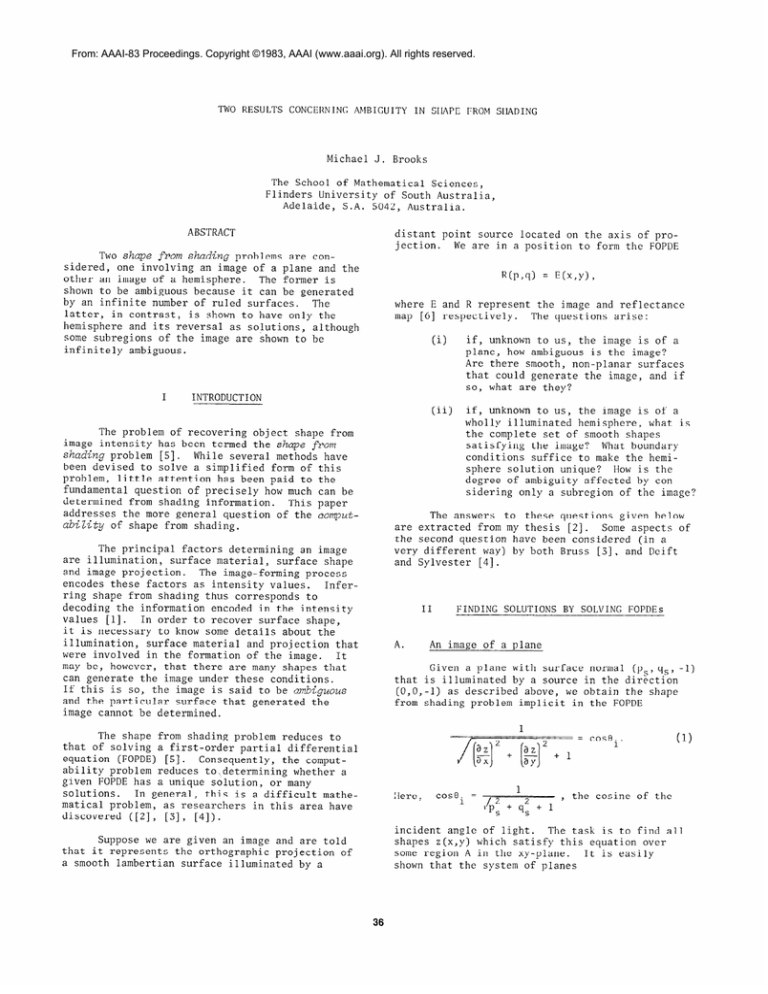
From: AAAI-83 Proceedings. Copyright ©1983, AAAI (www.aaai.org). All rights reserved.
TWO RESULTS CONCERNING AMBIGUITY IN SIlAPEFROM SHADING
Michael J. Brooks
The School of Mathematical Sciences,
Flinders University of South Australia,
Adelaide, S.A. 5042, Australia.
ABSTRACT
distant point source located on the axis of projection. We are in a position to form the FOPDE
Two shape from shading problems are considered, one involving an image of a plane and the
other an image of a hemisphere. The former is
shown to be ambiguous because it can be generated
by an infinite number of ruled surfaces. The
latter, in contrast, is shown to have only the
hemisphere and its reversal as solutions, although
some subregions of the image are shown to be
infinitely ambiguous.
I
R(p,q) = E(x,Y),
where E and R represent the image and reflectance
map [6] respectively. The questions arise:
(i)
if, unknown to us, the image is of a
plane, how ambiguous is the image?
Are there smooth, non-planar surfaces
that could generate the image, and if
so, what are they?
INTRODUCTION
(ii) if, unknown to us, the image is of a
wholly illuminated hemisphere, what is
the complete set of smooth shapes
satisfying the image? What boundary
conditions suffice to make the hemisphere solution unique? How is the
degree of ambiguity affected by considering only a subregion of the image?
The problem of recovering object shape from
image intensity has been termed the shape from
shading problem [S]. While several methods have
been devised to solve a simplified form of this
problem, little attention has been paid to the
fundamental question of precisely how much can be
determined from shading information. This paper
addresses the more general question of the cowrputabiZity of shape from shading.
The answers to these questions given below
are extracted from my thesis [2]. Some aspects of
the second question have been considered (in a
very different way) by both Bruss [3], and Deift
and Sylvester [4].
The principal factors determining an image
are illumination, surface material, surface shape
and image projection. The image-forming process
encodes these factors as intensity values. Inferring shape from shading thus corresponds to
decoding the information encoded in the intensity
values [l]. In order to recover surface shape,
it is necessary to know some details about the
illumination, surface material and projection that
were involved in the formation of the image. It
may be, however, that there are many shapes that
can generate the image under these conditions.
If this is so, the image is said to be uflbiguous
and the particular surface that generated the
image cannot be determined.
II
A.
FINDING SOLUTIONS BY SOLVING FOPDEs
An image of a plane
Given a plane with surface normal (ps,qs, -1)
that is illuminated by a source in the direction
(0,0,-l) as described above, we obtain the shape
from shading problem implicit in the FOPDE
-/jq-qg-T=
The shape from shading problem reduces to
that of solving a first-order partial differential
equation (FOPDE) [S]. Consequently, the computability problem reduces to,determining whether a
given FOPDE has a unique solution, or many
solutions. In general, this is a difficult mathematical problem, as researchers in this area have
discovered ([2], [3], [4]).
:Ierc, coy
=
1
case..
1
(1)
, the cosine of the
l/p2
2+1
s + 9s
incident angle of light. The task is to find all
shapes z(x,y) which satisfy this equation over
some region A in the xy-plane. It is easily
shown that the system of planes
Suppose we are given an image and are told
that it represents the orthographic projection of
a smooth lambertian surface illuminated by a
36
z(x,y) = ax + Jt2 - a2 y + C
(where t = tanei)
satisfies (1).
Therefore, providing p and q are
not both equal to zero, the image is agbiguou$
because it can be satisfied by an infinite number
of planes. This is obvious when we consider the
reflectance map which provides precisely the set
of planes that have a given intensity value (in
this case, the set will be one-dimensionally
infinite). It remains to determine whether there
are non-planar solutions satisfying (1).
Indeed
there are, since any sections of the cones
= + t2 J(x - a>2 + (y - aI2 + Y
z(x,y)
will satisfy (1) providing the point (a,3) does
not belong to the region A (for otherwise the
solution would fail to be smooth). Furthermore, it
can be shown that the system of surfaces captured
by the parametric form
r(e,@) = a(e) + @(@I,
(2)
where
Figure 1
a(e) = (+(e)cose
- $'(e)sine,+(e)sine+ +f(e)cose,
b(8) = (c0se
0)
Ruled surface solutions to an image of a
plane can be constructed by generating
functions a and b (using equation (2))
and employing them as shown.
, sine, -t),
(4)
will satisfy (1) for any smooth function $ that is
supplied. Naturally, it will be necessary to
ensure that a given solution is well-defined and
single-valued over A, but some sections of any of
the solutions will satisfy (1) after undergoing a
suitable translation and dilation (which will
always be permitted since the image is of constant
intensity).
Now, the system of surfaces
z(r,e) = kB + g(r,k) + M
will satisfy (4) provided that
The general solution to (1) given above also
shows, interestingly, that all solutions are ruled
surfaces (figure 1).
2
i% I
k2
+-=-.
r2
r2
1 - r2
Consequently, if we choose
B.
An image of a hemisphere
g(r,k) = -I
-
we obtain
z(r,e;k,M) = kB f
/H2+i
2-5
aY1
2
= Jl -
x2
-
y2
___-
-
(3)
+1
This is a two-parameter solution with the
following properties:
(i>
over various regions A 2 ((x,y) : x2 + y2 < 1).
The hemisphere of radius 1 and its concave
reversal given by
z(x,y)
-'
For a hemisphere imaged under the conditions
described in section 1, the shape from shading
problem reduces to finding shapes z(x,y) that
satisfy the equation
z(r,e;O,M) = f
= k jl - x2 - y2 + C
v----
r2
dr+bl=kJ1-r2+C
____
1 - r2
which correspond to the hemisphere solutions
given above.
are solutions to the equation. To determine
other solutions, it is useful to transform (3)
into the equivalent polar form
(ii) g(r,k) is only defined for
L>k'.
1 - r2
37
r2
Thus we require that
for some sections of the image. Figure 3a shows
some subregions over which thereexistmanysolutions
and figure 3b shows some subregions over which
there exist only two solutions.
kik2 +4-k2
-<r2<1
2
and so when k # 0, z(r,B;k,M) is defined
only over an annulus in the z = 0 plane.
(iii) when k # 0, z(r,e;k,M) is not periodic over
27rand is therefore not smooth over
: 0 5 r < 11.
1 he>
(iv) g(r,k) is bounded since
As r -t 1, g(r,k) -f 41 - ri .
The k # 0 solutions to (3) are helical bands
defined over an annulus in the z = 0 plane. Any
graph defined over 0 4 8 I 2~ that is selected
from one of these solutions will not be smooth.
Figure 2 gives an example of such a graph.
(b)
Figure 3
Shaded subsets of an image of
a hemisphere. The subsets in
figure (a) have an infinite
number of solutions, while
those in figure (b) have two.
Any subregion of C ( X,Y) : 0 < x2 + y2 < 1)
that does not completely surround the point
(X>Y) = (0,O) will have nfinitely many solution
shapes. Conversely, any subregion of
that contains or
c (X,Y> :o<x2+y2<1
surrounds (x,y) = (0,O) will have only two solution
shapes -the hemisphere and its reversal. The
inclusion of the point (x,y) = (0,O) in the image
severely constrains the number of possible
solutions. This is not surprisingwhen we reconsider (3) and note that the surface normal of
any solution at (O,O,z) is bound to be (0,0,-l).
111
Figure 2
CONCLUSION
Our understanding of the computability of
shape from shading must be improved. This will
lead to a better appreciation of the limitations
of current algorithms, and will help reveal the
boundary conditions necessary for a solution to be
determined. For example, it will prove useful to
know that a region of constant intensity must
correspond to a ruled surface (if it was formed
according to the conditions given earlier). Any
available boundary conditions can then further
reduce the size of this already restricted solution
set.
Under the conditiojlsdescribed
in the text, the helical band
shown above will look the same
as a similar portion of a hemispherical bowl. Some sections
of an image of a hemisphere
are therefore ambiguous.
Brooks [2] shows that there are no solutions
other than the hemisphere and its reversal that
satisfy (3) over the whole of the disc
{(x,y)
: x2 + y2< 11". However, this is not true
XThis requires consideration of possible envelope
solutions.
38
ACKNOWLEDGEMENTS
I would like to thankJohn Rice for his mathematical assistance and encouragement. Bruce Nelson
offered valuable comments on a draft of this paper.
REFERENCES
[II
Barrow, H.G. and Tenenbaum, J.M., (1978).
Recovering intrinsic scene characteristics
from images, in Computer Vision Systems,
Hanson, A. and Riseman, E. (eds.),Academic
Press.
E21
Brooks, M.J.,(1982). Shape from shading
discretely, Ph.D. thesis, Department of
Computer Science, Essex University.
[31
Bruss, A.R., (1981). The image irradiance
equation: its solution and application, Ph.D.
thesis, Artificial Intelligence Lab.,
Massachusetts Institute of Technology.
[41
Deift, P. and Sylvester, J., (1981). Some
remarks on the shape-from-shading problem in
computer vision, Journal of mathematical
analysis and applications, 84, pp. 235-248.
[51
Horn, B.K.P., (1970). Shape from shading:
a method for obtaining the shape of a smooth
opaque object from one view, MAC TR-79, MIT.
C61
Horn, B.K.P., (1977). Understanding image
intensities, Artificial Intelligence, 8,
pp. 201-231.


